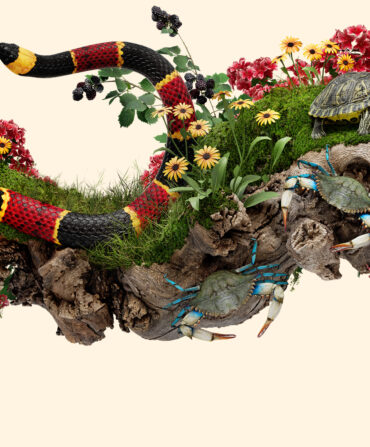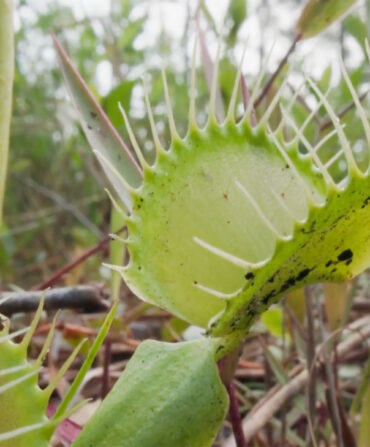Land & Conservation
Hope on the Half Shell
Caretakers of a generations-old seafood business in the historic Georgia community of Harris Neck, a father and son look toward the promise of modern oyster farming to preserve a legacy—and a way of life—inextricably tied to the water
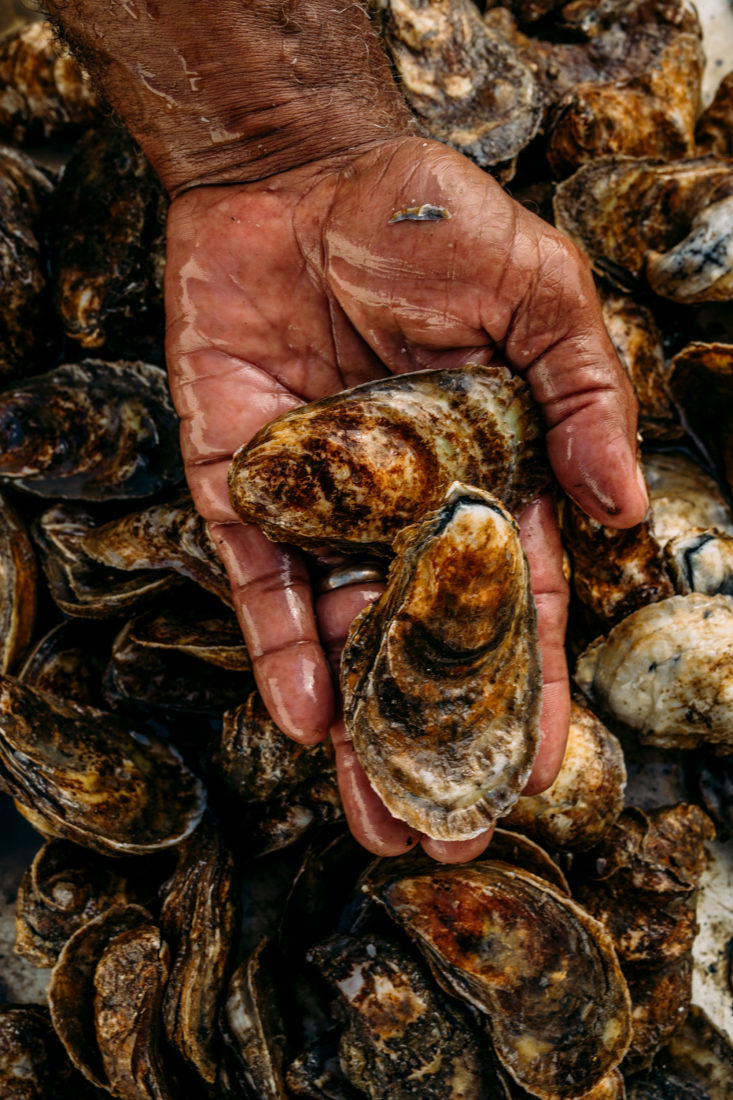
Photo: Bill Phelps
A Harris Neck morning rouses at its own pace.
Pine tops silhouette against a peach dawn slipping west over the salt marsh. Oak limbs droop over unpaved roads and delay daybreak like bedcovers pulled over sleepy heads. Nothing wakes faster than it must.
Silence and slowness so infuse this isolated corner of coastal Georgia, McIntosh County, roughly an hour south of Savannah, that tufted titmice trills overpower the sporadic grunt of diesel engines trucking workers to labors elsewhere. Hustle unfolds here in studied fashion, embodied full form by the slim frame of oysterman Earnest McIntosh Sr., who, at 7:00 a.m. on a mid-August Friday, sounds worried about losing minutes in the day but strides forward confident he can make up the time.

Photo: Bill Phelps
Left to right: Earnest McIntosh Jr., Najay White, and Earnest McIntosh Sr. of E.L McIntosh
“We’re going to have to hurry,” he says midglide across fescue surrounding his low-slung mint-green-colored home, passing a jon boat on his way to a backyard workshop. He wears a Prussian blue T-shirt tucked into jeans; a gold chain loops his neck and accentuates rich curls of gray hair. His call stirs his crew. His son, thirty-four-year-old Earnest Jr., trails behind, clutching a Styrofoam cup of molten gas station coffee. The resemblance to his father is uncanny, although an adolescence spent under football pads has yielded a tight end’s shoulders. A nephew, twenty-year-old Najay White, the newest addition to the shellfishing team, is also about; he stretches after snatching a few extra winks in the passenger seat of his maroon sedan. They gather under a roof extending off a walk-in cooler—a way station for market-bound oysters and crabs—to grab the work gloves and hip waders necessary for the day’s labor.
“We won’t have much tide,” Earnest Sr., who is sixty-six, instructs. He knows that his shellfish investment—thousands and thousands of oysters stored in wire mesh cages cached along the maze of creeks that snake through the Lowcountry’s spartina expanses—requires his attention today, and most likely tomorrow, too. Officially, these will be the first farmed Georgia oysters to come to market. They also represent a sea change in how E.L. McIntosh & Son Seafood does business, a wholesale transition away from the wild harvest techniques of old to aquaculture, as science-based seafood farming is called.
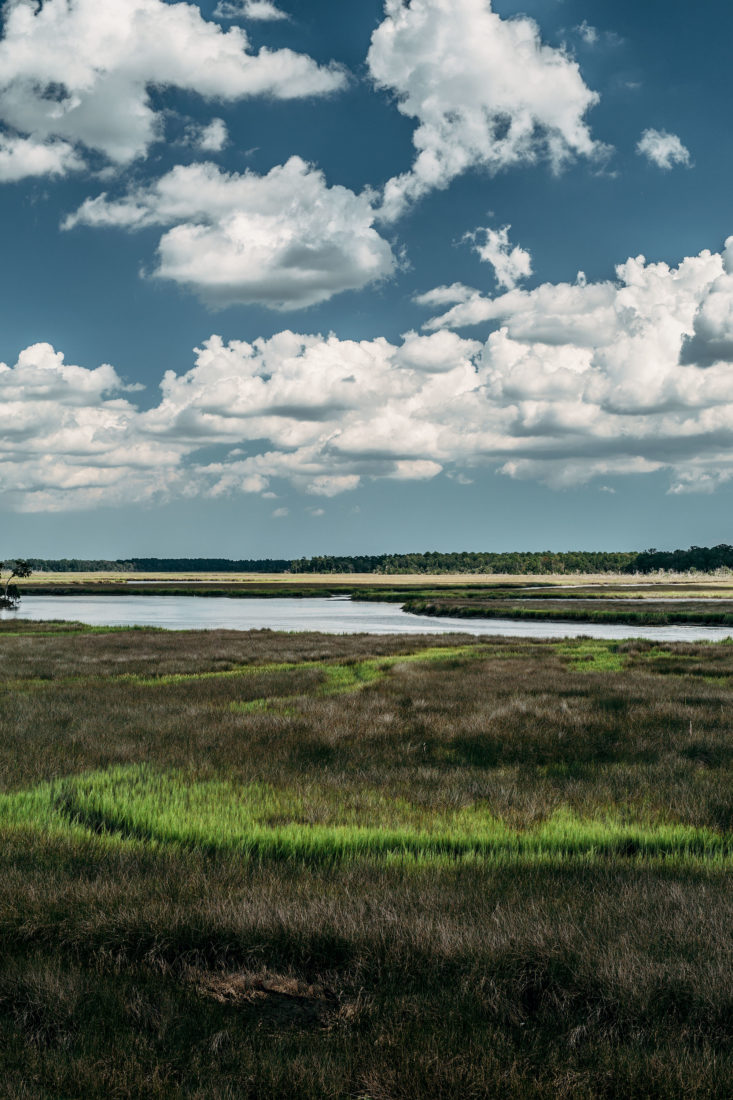
Photo: Bill Phelps
A view of the marsh.
Virginia, the Carolinas, and some Gulf of Mexico states have
all seen oyster farming bolster their fishing industries in recent years. Throughout the twentieth century, overharvesting and environmental degradation decimated natural oyster populations around the country. Aquaculture has revived the ailing trade, especially over the last decade in the South, where new oyster farms now serve a proliferation of high-end raw bars opened in tandem with the bivalves’ growing abundance.
Still, the renaissance has not benefited all equally. Some states have adopted aquaculture practices far more slowly than their neighbors. Georgia has taken a cautious approach as regulators attempt to balance the interests of sportfishermen and others who use the waterways. To start their operation, the McIntoshes advocated to the state’s Department of Natural Resources and obtained a provisional oyster farming permit. Furthermore, African Americans, who made up much of the oyster industry’s traditional workforce in the South, have been noticeably absent from the new boom. Historically, black watermen harvested oysters, and black women shucked and packed them for shipping to white-owned seafood businesses. Today black oyster farmers are as rare as natural pearls.

Photo: Bill Phelps
Spraying off oyster cages.
“Earnest has a real possibility to be a mentor to a lot of people who are interested in keeping their family legacy alive,” says Mashama Bailey, chef at the Grey in Savannah, which opened in late 2014. Bailey first met the McIntoshes while working with the Southeastern African American Farmers’ Organic Network, an organization dedicated to preserving African American agricultural heritage, to find local producers to feature on her menu. She found little in the way of black seafood providers beyond the McIntoshes. “There’s so much possibility and potential,” she says.
The shift away from wild harvesting necessitates resourcefulness and attention to detail, but that’s been de rigueur McIntosh practice for decades.
Earnest Sr. tosses gear into the bed of his truck and notes that the tide won’t drain the river as low as it should. What’s more, water will surge back from Sapelo Sound faster than he’d like. This limits the team’s access to the cages and ability to get work done. So today’s tasks—raising the cages and shaking and pressure washing the oysters to clean them of mud, barnacles, and seaweed—must be concluded in record time. Najay and Earnest Jr. accept their orders with a nod, and soon Earnest Sr.’s hunter-green pickup carries the men toward the water.
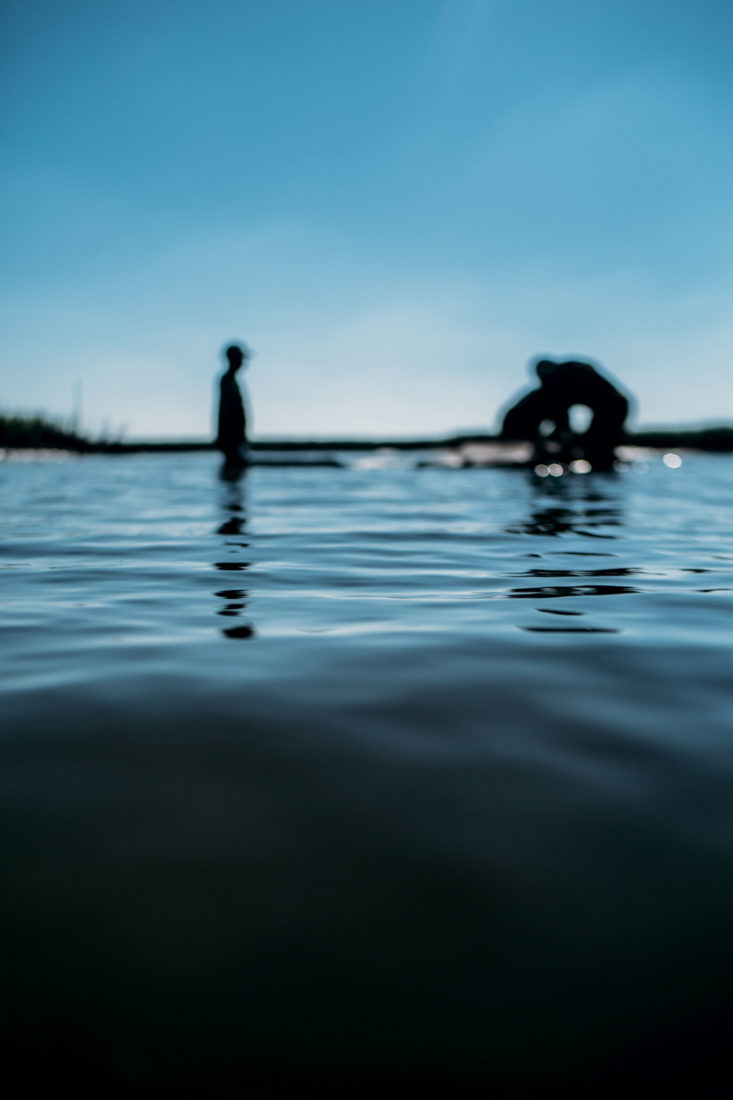
Photo: Bill Phelps
The team at work.
They’ve made this commute innumerable times, but there’s
a heightened urgency now as October approaches, when regulators open the oyster season and the McIntoshes can legally begin delivering the crop to keen restaurants, including the Grey and Decatur, Georgia’s Kimball House.
The wild oyster harvests of old haven’t delivered riches to the family. Harvesting a wild bushel—muddy, craggy clusters (oyster glommed on to oyster) native to the region’s salt marshes and integral to Lowcountry roasts—requires hours bent over in the elements, cracking clusters apart with a metal tool. The tasks of farming, by contrast, can be planned, managed. What’s more, a farmed oyster, single and beautiful, suitable for half-shell service at the finest restaurants, can fetch as much as four times the price.
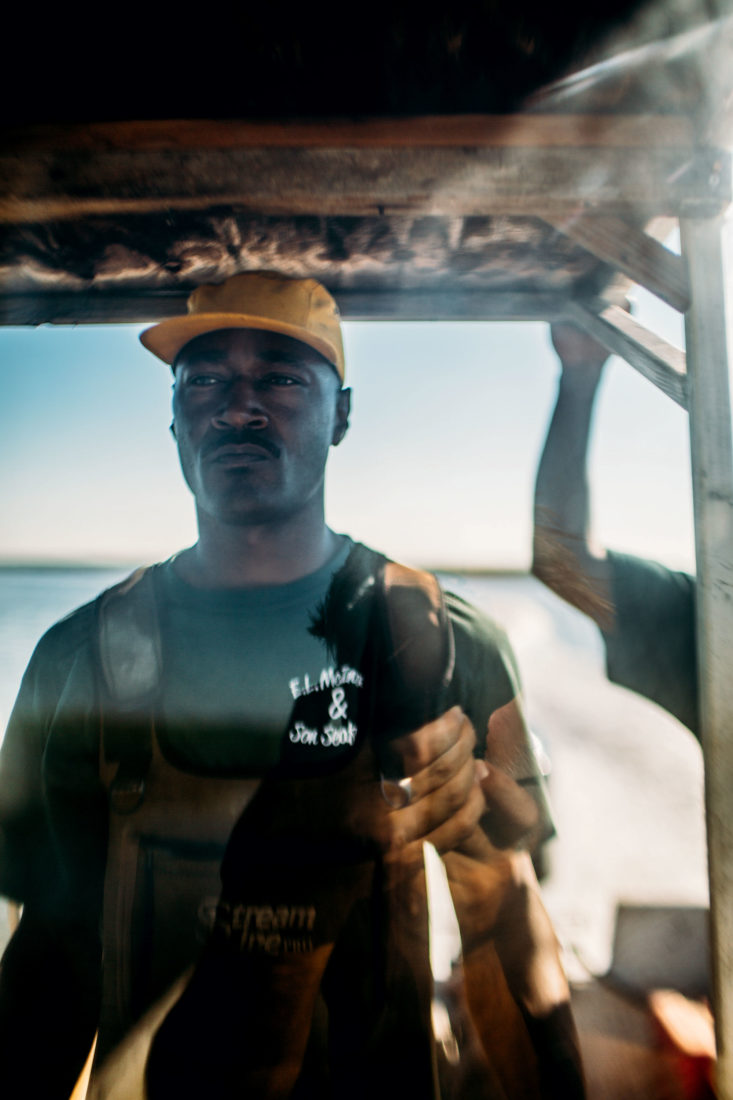
Photo: Bill Phelps
Earnest Jr. surveys the water.
A better payday entices, of course, but there’s a grander plan drawn up. Earnest Sr. believes oyster farming will lift him “above the fray,” set him apart from the hardscrabble, cutthroat competition of chasing wild crabs and bushel oysters and create something that can last for decades to come. Earnest Jr. also casts his hopes ahead. He left Harris Neck—historically a community populated by the descendants of enslaved people—on a college football scholarship but returned after a few semesters. He rose through the ranks at Sea Tow, a boater’s assistance service, but the job often kept him away from his wife and children, and he decided instead to join his father in the family business. There are worse ways to make a living, he says, than working alongside your old man. Now he’s eager to help create a legacy that he can nurture and pass on to his seven children. Better yet, he says, “those oysters could put all my kids through college. Out there, that’s my destiny.”
The two-mile drive east on Harris Neck Road from Earnest Sr.’s house to where the McIntoshes dock their boats along the Barbour River passes landmarks in family and community history. The path recalls ways of life that once were—ways of life that the family hopes to continue, if in a new way.
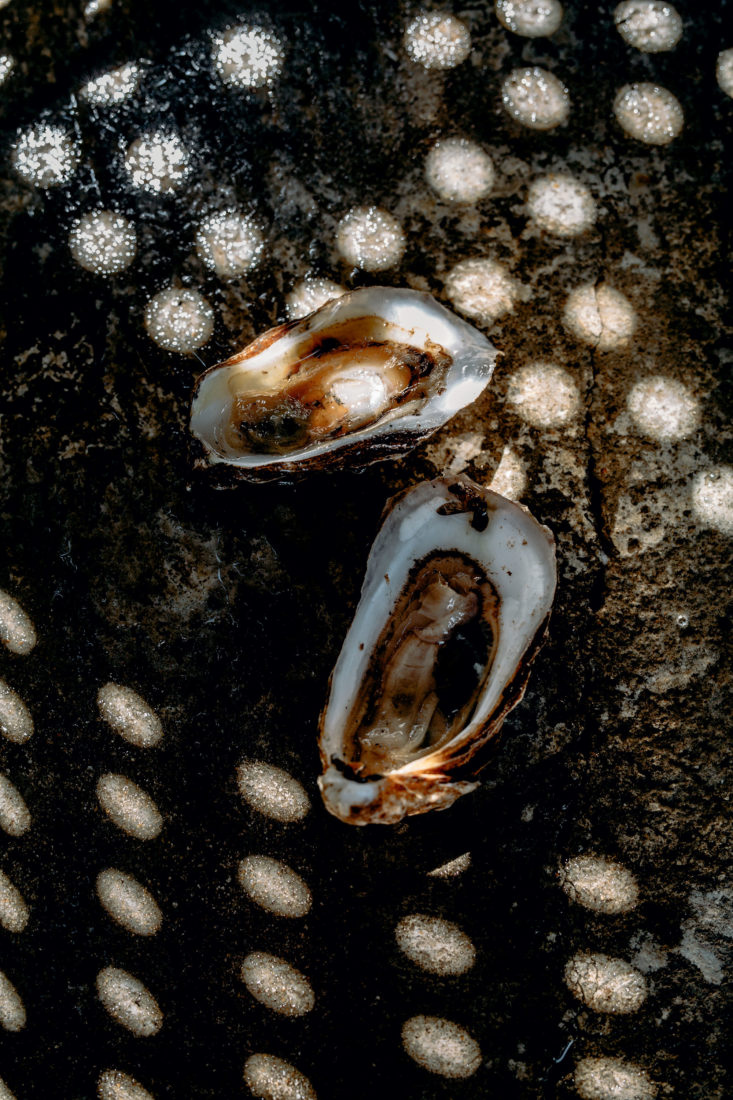
Photo: Bill Phelps
Half-shell beauties.
Peer down Blue Crab Lane and a cinder-block building, painted red and in need of new shingles, is all that remains of the McIntosh Crab Plant, the life’s work of Earnest Sr.’s father, Christopher McIntosh. At the plant’s apex in the 1970s, the McIntoshes employed fifty area residents hauling crabs back to shore and picking meat. Earnest Sr. was the only one of seven sons to accept the inheritance, but he was not bequeathed the same prosperity. The plant closed in the early 1990s as demand for picked crab meat decreased, and as the century turned, fewer residents looked to the water for work. In response, Earnest Sr. added wild oysters to his business, long a part of Harris Neck culture. The old oyster canneries once employed many residents, and harvesting the shellfish for subsistence has been a community tradition for generations, part of a portfolio of catches—including shrimp, fish, and crabs—that people relied on to pad savings and fill bellies.
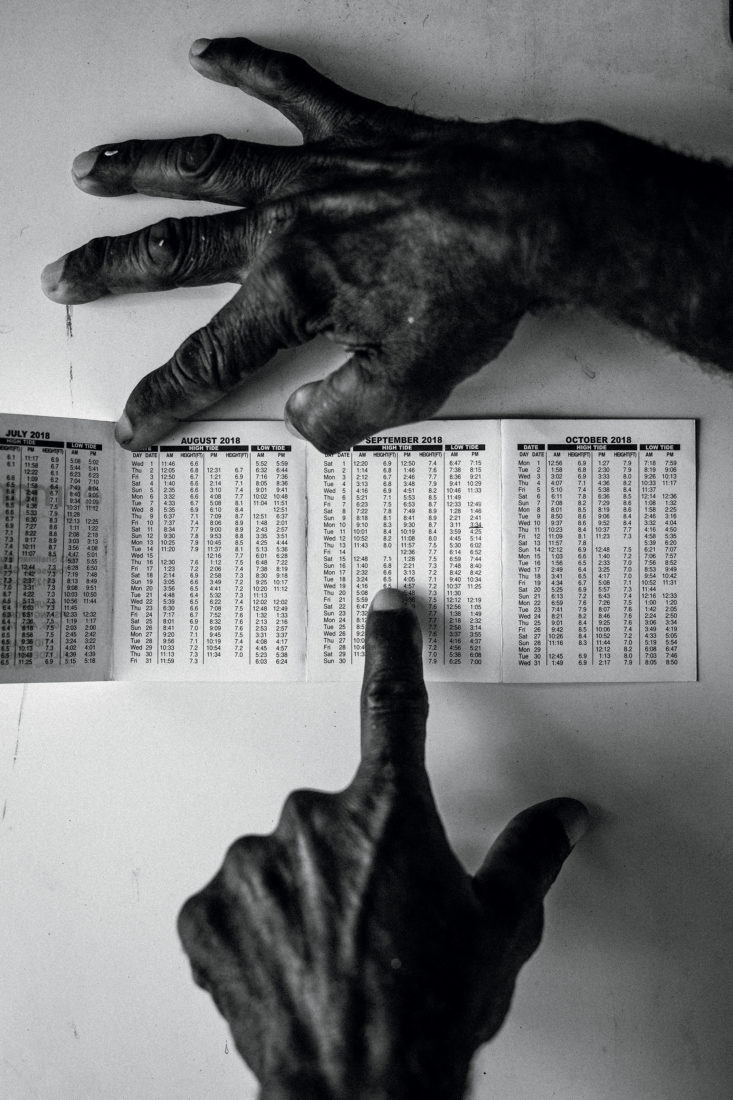
Photo: Bill Phelps
Checking the tide charts.
“Around here, that’s all that’s ever been—seafood,” Earnest Sr. says. But sustaining a livelihood in places roiled by wave action, hurricanes, and human interference demands incredible effort. People in Harris Neck know that better than most.
The last stretch of the drive regularly reminds the community’s black residents what they’ve lost. The truck veers left through gates marked Harris Neck National Wildlife Refuge, an expanse of wetlands, ponds, and forests maintained by the U.S. Fish & Wildlife Service on land that the McIntoshes’ ancestors once called home. After the Civil War, Margaret Ann Harris, the property’s owner, willed the land now bounded as this refuge to a previously enslaved man she had owned, and soon a free community of fishermen and farmers thrived in relative peace for decades.
During World War II, the U.S. Department of War used eminent domain to acquire almost three thousand acres of Harris Neck to build an air base, paying owners a pittance for their loss. Churches and homes were destroyed to make way for barracks and hangars. Harris Neck’s residents believed that land would be returned to them once the warplanes left. Instead, when the war ended, federal officials offered the land to the McIntosh County government to use as an airport. County leaders, whose corruption the author Melissa Fay Greene documented in Praying for Sheetrock, a National Book Award finalist, used it for their own purposes, including turning one of the military buildings into a private club. The federal government eventually stepped in again, usurping the land and refashioning it as the current refuge in 1962. A long legal battle to return it to the displaced families continues to this day.
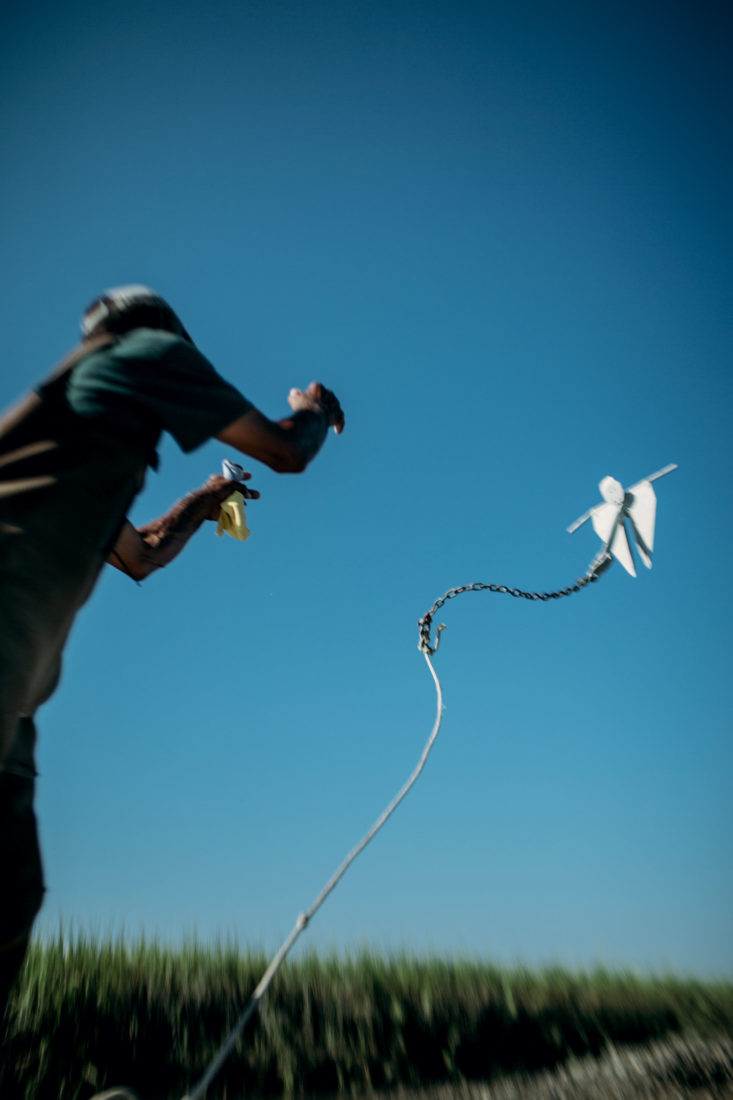
Photo: Bill Phelps
Anchoring up.
The McIntoshes begin their labor each morning in the shadow of this history, but they have little time to be burdened by it. Work on the water promises freedom, self-determination, independence. Whatever struggle leads them to the river’s edge is a crucible worth enduring.
“Nobody can take this away from us,” Earnest Jr. says, surveying the marsh after his father parks the truck at the crest of a bluff overlooking the Barbour. He speaks as a man who chose a waterman’s life and entrepreneurial toil beside his father instead of a salary or benefits. He speaks as a man for whom there is no other place to be. Auric threads of cordgrass unfurl before him, interrupted by the flow of tidewater egressing to the Atlantic Ocean a few miles beyond. “This is God’s gift.”
Free from a no-wake zone, the McIntoshes’ fiberglass boat gains speed as it skims forward into the salt marsh toward their lease, known locally as Julienton Plantation. Low tide exposes the sloping banks of spartina islands and the tips of wild oyster clusters, razor sharp and gleaming white. Earnest Jr. decelerates, curves west into a narrow creek, and draws the motor to a halt. The boat’s wake splashes against the edges of black rectangular cubes, now surfacing as the water ebbs. “There they are,” says Earnest Sr., green eyes alight like a father separated too long from his family: There are his oysters, secure in their cages.
He and Najay leap over the gunwale with a splash while Earnest Jr. remains on board, setting up a gas-powered pressure washer. Feet sinking into pluff mud, the men haul up a cage—roughly four feet by two feet—unhook a latch, and draw out mesh bags stuffed with oysters. These oysters have been growing here for more than a year after beginning their lives in a hatchery run by the University of Georgia. The McIntoshes buy young oysters from the hatchery when the shells are a quarter to a half inch long, then set them out in cages on their leased waterways in locations chosen for tide access and wave action. It’s the McIntoshes’ job to keep them safe and clean, shaking and washing the cages while the animals filter feed and fatten on phytoplankton.
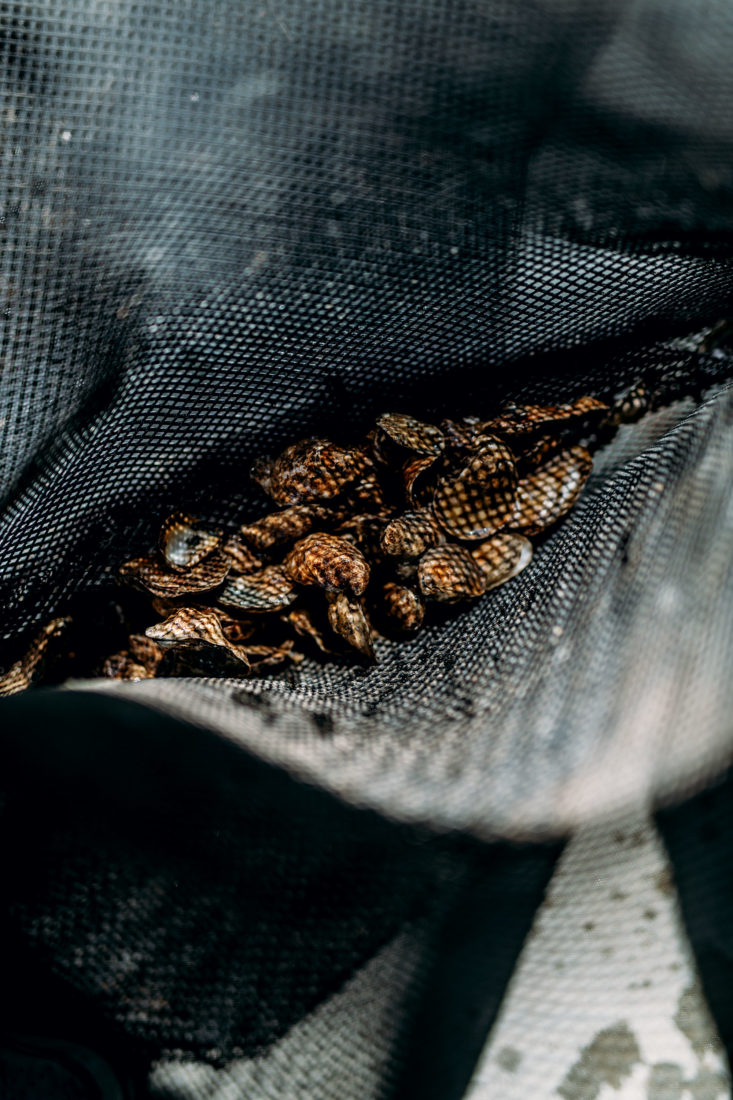
Photo: Bill Phelps
Oysters grow inside mesh bags.
Earnest Jr. mans the washer nozzle and sprays glops of mud and small crabs off the oysters within the bags. The rinse reveals plump shells more than two inches long, tinged bronze by sediment flushed from upriver, coppery jewels encasing a briny gift. Each bag contains around 150 oysters. Each cage holds six bags, and there are fourteen cages in this particular creek. In a manner that defends details as an industry secret, Earnest Jr. casts his eyes over acres of marsh to the west and offers a vague population estimate. “From here to the tree line,” he says, “we’ve got oysters everywhere.”
Najay continues to spray as Earnest Jr. rests to inspect a wild oyster bed in the central part of the creek. This bed has been worked. Typically, wild Lowcountry oysters root like leaden bouquets reaching from the mud toward the sky. The McIntoshes broke down these clusters on previous trips, whittling off small exterior shells with metal bars to reveal a long, choice bivalve at the cluster’s stem, then leaving it to fatten. The watermen call this a wild single. “It’s a wild oyster we make look like it’s farmed,” Earnest Jr. says. While the McIntoshes were working to establish their farmed oysters, wild singles provided sustenance to the family: Mashama Bailey offered them a prized spot on her menu at the Grey. When the chef Sean Brock opened the Savannah location of his Husk restaurant in 2017, he did the same. But the process is tedious and difficult and less consistent, akin to chiseling gems out of the rough. If all goes according to plan, they’ll now have thousands of beautiful oysters ready to ship to clients waiting in Atlanta and as far away as Detroit.
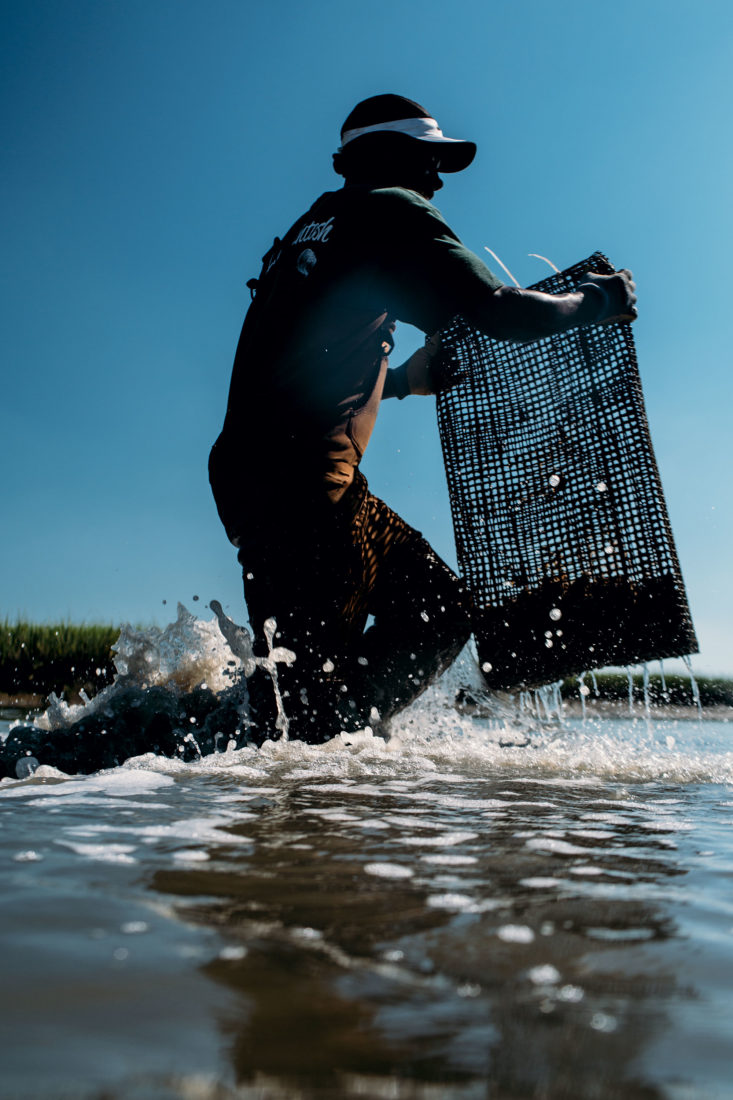
Photo: Bill Phelps
Hoisting oysters for cleaning.
They’re also doing Harris Neck a promotional favor. Few foods travel bound with narrative as an oyster does. Perhaps a diner peruses a raw-bar menu, notes the appellation of Harris Neck, and asks herself where that place might be. An oyster communicates a story to the world in a slurp and invites eaters to visit its birthplace, even if only in their minds. The experience undergirds heritage in a world with scant interest in the past.
No matter what, there are no other oysters like Harris Neck oysters, the McIntoshes say, salty, with brilliant vegetal hints absorbed from the spartina. Aficionados call this the oyster’s merroir, an analogue to wine’s terroir, its flavor a representation of the particular environment in which it grows. “They’re briny and then there’s a sweetness too,” Bailey says, and you can taste the marsh, a distinguishable “Lowcountry funk.”
The boat returns to the dock with one bag of oysters, not for sale, just for care. Earnest Sr. thought the bag looked overfilled, which could stifle the animals’ growth in the last weeks before market. Back at the workshed, the McIntoshes loose the oysters onto a metal table, cull for mortality, and divide the lot into two collections. They’ll be refrigerated overnight here until the team heads back out to the sea farm tomorrow. Earnest Sr. then diverts his thoughts to other matters of the Hill— the waterman’s term for dry land, anyplace where a boat can’t float. Engines need greasing, as do customer relations.
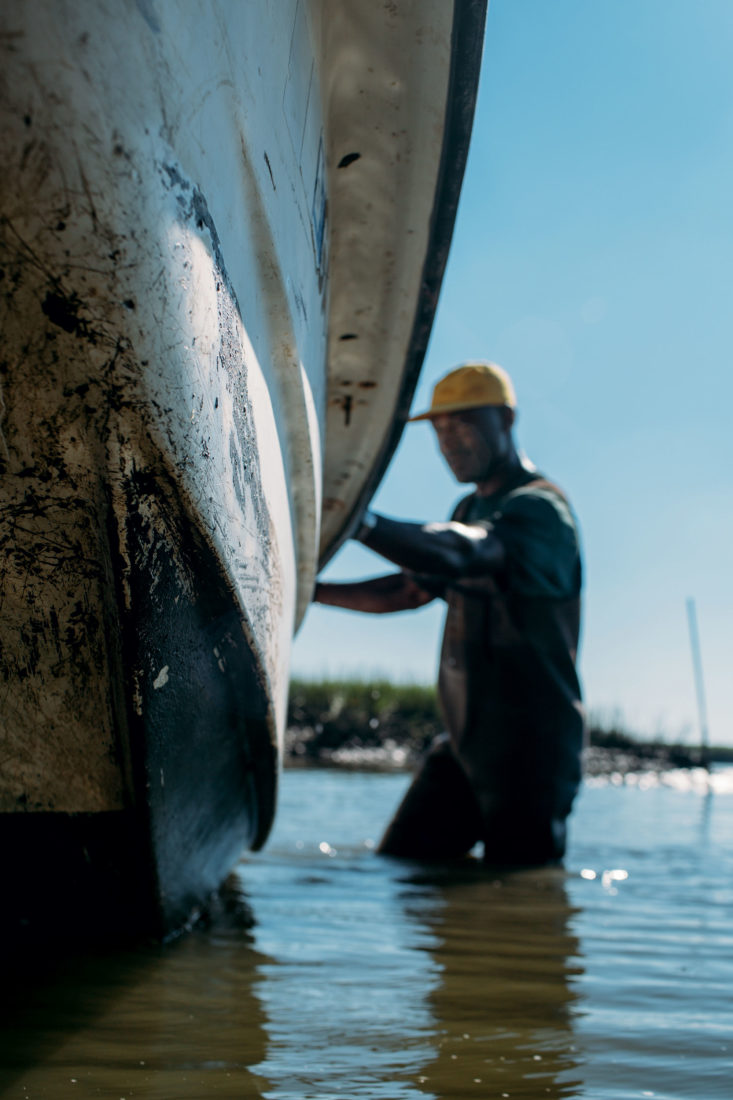
Photo: Bill Phelps
Earnest Jr. at the boat.
The water won’t stray far from his thoughts. Harris Neck marshes have always been a source of peace for Earnest Sr., an escape where his mind settles into labor’s calm. Though he oversees a nursery now, not a wilderness, his vigilance increases in step with his pride.
“You see oysters out there looking that good,” he says, “it’s hard to leave them.”
The McIntoshes are sentinels of this estuary and its catch, be it wild or farmed. Their role abides. The chores and duties may change, but this family is determined not to.


